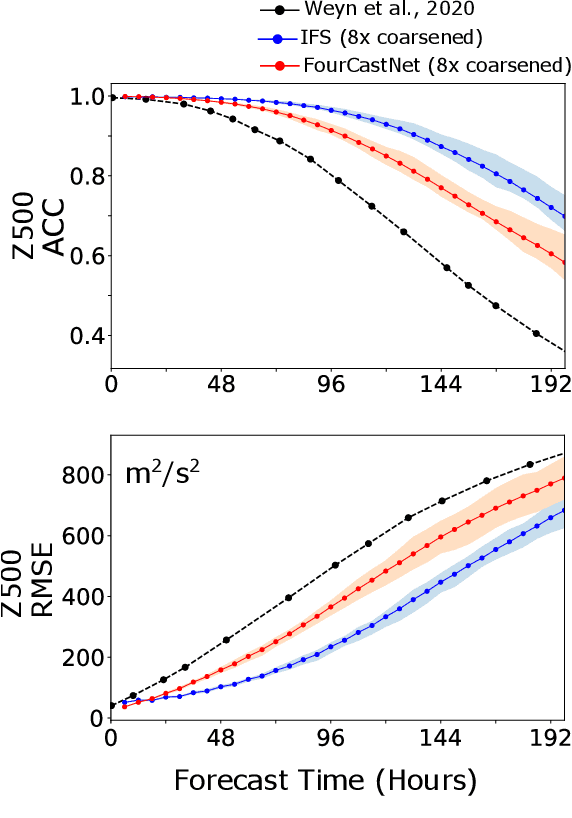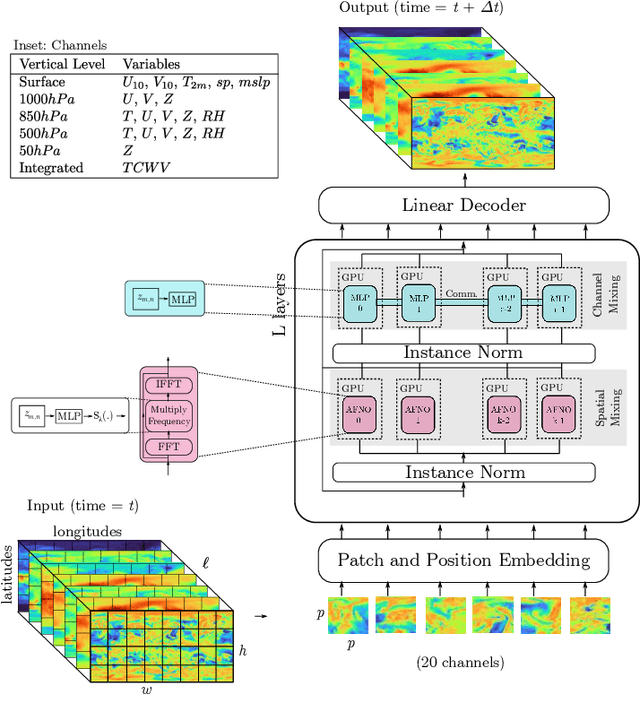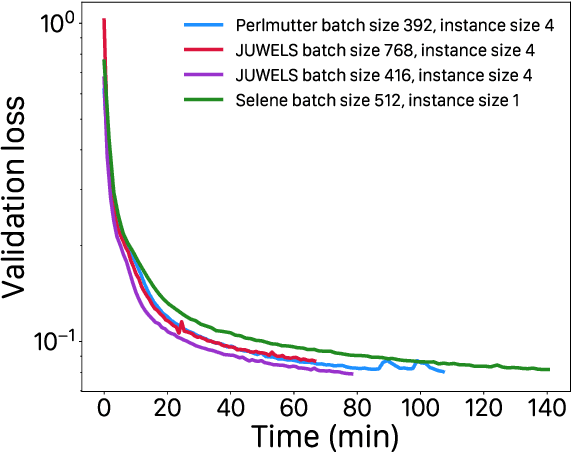Peter Harrington
Hierarchical Conditional Multi-Task Learning for Streamflow Modeling
Oct 18, 2024Abstract:Streamflow, vital for water resource management, is governed by complex hydrological systems involving intermediate processes driven by meteorological forces. While deep learning models have achieved state-of-the-art results of streamflow prediction, their end-to-end single-task learning approach often fails to capture the causal relationships within these systems. To address this, we propose Hierarchical Conditional Multi-Task Learning (HCMTL), a hierarchical approach that jointly models soil water and snowpack processes based on their causal connections to streamflow. HCMTL utilizes task embeddings to connect network modules, enhancing flexibility and expressiveness while capturing unobserved processes beyond soil water and snowpack. It also incorporates the Conditional Mini-Batch strategy to improve long time series modeling. We compare HCMTL with five baselines on a global dataset. HCMTL's superior performance across hundreds of drainage basins over extended periods shows that integrating domain-specific causal knowledge into deep learning enhances both prediction accuracy and interpretability. This is essential for advancing our understanding of complex hydrological systems and supporting efficient water resource management to mitigate natural disasters like droughts and floods.
Kilometer-Scale Convection Allowing Model Emulation using Generative Diffusion Modeling
Aug 20, 2024Abstract:Storm-scale convection-allowing models (CAMs) are an important tool for predicting the evolution of thunderstorms and mesoscale convective systems that result in damaging extreme weather. By explicitly resolving convective dynamics within the atmosphere they afford meteorologists the nuance needed to provide outlook on hazard. Deep learning models have thus far not proven skilful at km-scale atmospheric simulation, despite being competitive at coarser resolution with state-of-the-art global, medium-range weather forecasting. We present a generative diffusion model called StormCast, which emulates the high-resolution rapid refresh (HRRR) model-NOAA's state-of-the-art 3km operational CAM. StormCast autoregressively predicts 99 state variables at km scale using a 1-hour time step, with dense vertical resolution in the atmospheric boundary layer, conditioned on 26 synoptic variables. We present evidence of successfully learnt km-scale dynamics including competitive 1-6 hour forecast skill for composite radar reflectivity alongside physically realistic convective cluster evolution, moist updrafts, and cold pool morphology. StormCast predictions maintain realistic power spectra for multiple predicted variables across multi-hour forecasts. Together, these results establish the potential for autoregressive ML to emulate CAMs -- opening up new km-scale frontiers for regional ML weather prediction and future climate hazard dynamical downscaling.
Huge Ensembles Part I: Design of Ensemble Weather Forecasts using Spherical Fourier Neural Operators
Aug 06, 2024



Abstract:Studying low-likelihood high-impact extreme weather events in a warming world is a significant and challenging task for current ensemble forecasting systems. While these systems presently use up to 100 members, larger ensembles could enrich the sampling of internal variability. They may capture the long tails associated with climate hazards better than traditional ensemble sizes. Due to computational constraints, it is infeasible to generate huge ensembles (comprised of 1,000-10,000 members) with traditional, physics-based numerical models. In this two-part paper, we replace traditional numerical simulations with machine learning (ML) to generate hindcasts of huge ensembles. In Part I, we construct an ensemble weather forecasting system based on Spherical Fourier Neural Operators (SFNO), and we discuss important design decisions for constructing such an ensemble. The ensemble represents model uncertainty through perturbed-parameter techniques, and it represents initial condition uncertainty through bred vectors, which sample the fastest growing modes of the forecast. Using the European Centre for Medium-Range Weather Forecasts Integrated Forecasting System (IFS) as a baseline, we develop an evaluation pipeline composed of mean, spectral, and extreme diagnostics. Using large-scale, distributed SFNOs with 1.1 billion learned parameters, we achieve calibrated probabilistic forecasts. As the trajectories of the individual members diverge, the ML ensemble mean spectra degrade with lead time, consistent with physical expectations. However, the individual ensemble members' spectra stay constant with lead time. Therefore, these members simulate realistic weather states, and the ML ensemble thus passes a crucial spectral test in the literature. The IFS and ML ensembles have similar Extreme Forecast Indices, and we show that the ML extreme weather forecasts are reliable and discriminating.
Huge Ensembles Part II: Properties of a Huge Ensemble of Hindcasts Generated with Spherical Fourier Neural Operators
Aug 02, 2024



Abstract:In Part I, we created an ensemble based on Spherical Fourier Neural Operators. As initial condition perturbations, we used bred vectors, and as model perturbations, we used multiple checkpoints trained independently from scratch. Based on diagnostics that assess the ensemble's physical fidelity, our ensemble has comparable performance to operational weather forecasting systems. However, it requires several orders of magnitude fewer computational resources. Here in Part II, we generate a huge ensemble (HENS), with 7,424 members initialized each day of summer 2023. We enumerate the technical requirements for running huge ensembles at this scale. HENS precisely samples the tails of the forecast distribution and presents a detailed sampling of internal variability. For extreme climate statistics, HENS samples events 4$\sigma$ away from the ensemble mean. At each grid cell, HENS improves the skill of the most accurate ensemble member and enhances coverage of possible future trajectories. As a weather forecasting model, HENS issues extreme weather forecasts with better uncertainty quantification. It also reduces the probability of outlier events, in which the verification value lies outside the ensemble forecast distribution.
Analyzing and Exploring Training Recipes for Large-Scale Transformer-Based Weather Prediction
Apr 30, 2024Abstract:The rapid rise of deep learning (DL) in numerical weather prediction (NWP) has led to a proliferation of models which forecast atmospheric variables with comparable or superior skill than traditional physics-based NWP. However, among these leading DL models, there is a wide variance in both the training settings and architecture used. Further, the lack of thorough ablation studies makes it hard to discern which components are most critical to success. In this work, we show that it is possible to attain high forecast skill even with relatively off-the-shelf architectures, simple training procedures, and moderate compute budgets. Specifically, we train a minimally modified SwinV2 transformer on ERA5 data, and find that it attains superior forecast skill when compared against IFS. We present some ablations on key aspects of the training pipeline, exploring different loss functions, model sizes and depths, and multi-step fine-tuning to investigate their effect. We also examine the model performance with metrics beyond the typical ACC and RMSE, and investigate how the performance scales with model size.
* 9 pages, 6 figures
A Practical Probabilistic Benchmark for AI Weather Models
Jan 27, 2024Abstract:Since the weather is chaotic, forecasts aim to predict the distribution of future states rather than make a single prediction. Recently, multiple data driven weather models have emerged claiming breakthroughs in skill. However, these have mostly been benchmarked using deterministic skill scores, and little is known about their probabilistic skill. Unfortunately, it is hard to fairly compare AI weather models in a probabilistic sense, since variations in choice of ensemble initialization, definition of state, and noise injection methodology become confounding. Moreover, even obtaining ensemble forecast baselines is a substantial engineering challenge given the data volumes involved. We sidestep both problems by applying a decades-old idea -- lagged ensembles -- whereby an ensemble can be constructed from a moderately-sized library of deterministic forecasts. This allows the first parameter-free intercomparison of leading AI weather models' probabilistic skill against an operational baseline. The results reveal that two leading AI weather models, i.e. GraphCast and Pangu, are tied on the probabilistic CRPS metric even though the former outperforms the latter in deterministic scoring. We also reveal how multiple time-step loss functions, which many data-driven weather models have employed, are counter-productive: they improve deterministic metrics at the cost of increased dissipation, deteriorating probabilistic skill. This is confirmed through ablations applied to a spherical Fourier Neural Operator (SFNO) approach to AI weather forecasting. Separate SFNO ablations modulating effective resolution reveal it has a useful effect on ensemble dispersion relevant to achieving good ensemble calibration. We hope these and forthcoming insights from lagged ensembles can help guide the development of AI weather forecasts and have thus shared the diagnostic code.
Towards Stability of Autoregressive Neural Operators
Jun 18, 2023Abstract:Neural operators have proven to be a promising approach for modeling spatiotemporal systems in the physical sciences. However, training these models for large systems can be quite challenging as they incur significant computational and memory expense -- these systems are often forced to rely on autoregressive time-stepping of the neural network to predict future temporal states. While this is effective in managing costs, it can lead to uncontrolled error growth over time and eventual instability. We analyze the sources of this autoregressive error growth using prototypical neural operator models for physical systems and explore ways to mitigate it. We introduce architectural and application-specific improvements that allow for careful control of instability-inducing operations within these models without inflating the compute/memory expense. We present results on several scientific systems that include Navier-Stokes fluid flow, rotating shallow water, and a high-resolution global weather forecasting system. We demonstrate that applying our design principles to prototypical neural networks leads to significantly lower errors in long-range forecasts with 800\% longer forecasts without qualitative signs of divergence compared to the original models for these systems. We open-source our \href{https://anonymous.4open.science/r/stabilizing_neural_operators-5774/}{code} for reproducibility.
Towards Foundation Models for Scientific Machine Learning: Characterizing Scaling and Transfer Behavior
Jun 01, 2023Abstract:Pre-trained machine learning (ML) models have shown great performance for a wide range of applications, in particular in natural language processing (NLP) and computer vision (CV). Here, we study how pre-training could be used for scientific machine learning (SciML) applications, specifically in the context of transfer learning. We study the transfer behavior of these models as (i) the pre-trained model size is scaled, (ii) the downstream training dataset size is scaled, (iii) the physics parameters are systematically pushed out of distribution, and (iv) how a single model pre-trained on a mixture of different physics problems can be adapted to various downstream applications. We find that-when fine-tuned appropriately-transfer learning can help reach desired accuracy levels with orders of magnitude fewer downstream examples (across different tasks that can even be out-of-distribution) than training from scratch, with consistent behavior across a wide range of downstream examples. We also find that fine-tuning these models yields more performance gains as model size increases, compared to training from scratch on new downstream tasks. These results hold for a broad range of PDE learning tasks. All in all, our results demonstrate the potential of the "pre-train and fine-tune" paradigm for SciML problems, demonstrating a path towards building SciML foundation models. We open-source our code for reproducibility.
Generative Modeling of High-resolution Global Precipitation Forecasts
Oct 22, 2022Abstract:Forecasting global precipitation patterns and, in particular, extreme precipitation events is of critical importance to preparing for and adapting to climate change. Making accurate high-resolution precipitation forecasts using traditional physical models remains a major challenge in operational weather forecasting as they incur substantial computational costs and struggle to achieve sufficient forecast skill. Recently, deep-learning-based models have shown great promise in closing the gap with numerical weather prediction (NWP) models in terms of precipitation forecast skill, opening up exciting new avenues for precipitation modeling. However, it is challenging for these deep learning models to fully resolve the fine-scale structures of precipitation phenomena and adequately characterize the extremes of the long-tailed precipitation distribution. In this work, we present several improvements to the architecture and training process of a current state-of-the art deep learning precipitation model (FourCastNet) using a novel generative adversarial network (GAN) to better capture fine scales and extremes. Our improvements achieve superior performance in capturing the extreme percentiles of global precipitation, while comparable to state-of-the-art NWP models in terms of forecast skill at 1--2 day lead times. Together, these improvements set a new state-of-the-art in global precipitation forecasting.
FourCastNet: Accelerating Global High-Resolution Weather Forecasting using Adaptive Fourier Neural Operators
Aug 08, 2022



Abstract:Extreme weather amplified by climate change is causing increasingly devastating impacts across the globe. The current use of physics-based numerical weather prediction (NWP) limits accuracy due to high computational cost and strict time-to-solution limits. We report that a data-driven deep learning Earth system emulator, FourCastNet, can predict global weather and generate medium-range forecasts five orders-of-magnitude faster than NWP while approaching state-of-the-art accuracy. FourCast-Net is optimized and scales efficiently on three supercomputing systems: Selene, Perlmutter, and JUWELS Booster up to 3,808 NVIDIA A100 GPUs, attaining 140.8 petaFLOPS in mixed precision (11.9%of peak at that scale). The time-to-solution for training FourCastNet measured on JUWELS Booster on 3,072GPUs is 67.4minutes, resulting in an 80,000times faster time-to-solution relative to state-of-the-art NWP, in inference. FourCastNet produces accurate instantaneous weather predictions for a week in advance, enables enormous ensembles that better capture weather extremes, and supports higher global forecast resolutions.
 Add to Chrome
Add to Chrome Add to Firefox
Add to Firefox Add to Edge
Add to Edge